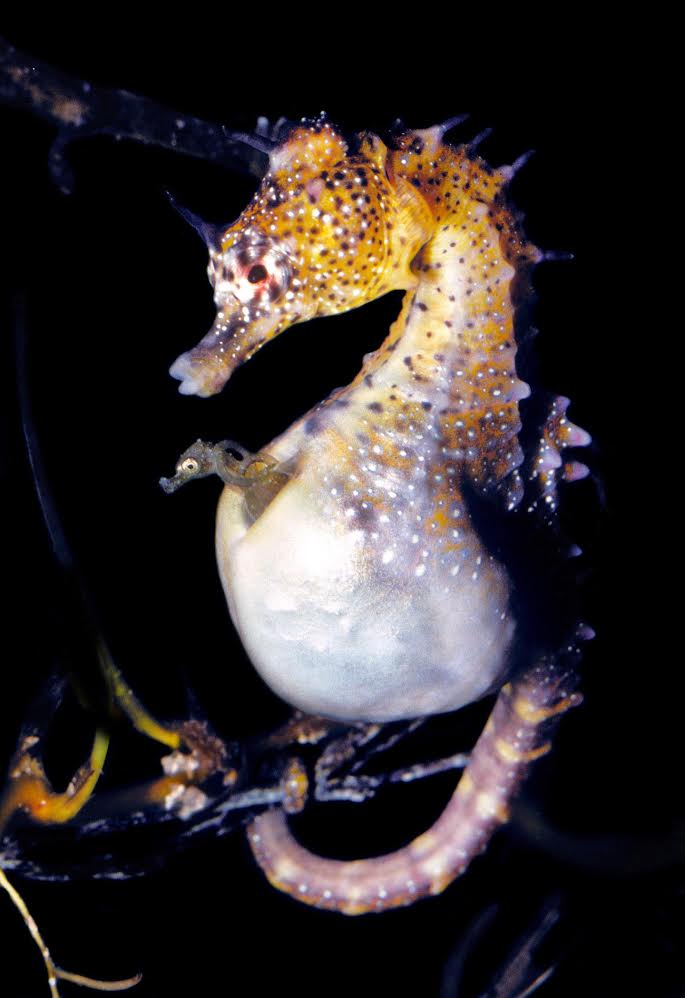
She is the author of My Husband and Other Animals.…
Animals do the most amazing things. Read about them in this series by Janaki Lenin.
The ones left holding the babies among seahorses, pipefishes, and seadragons are the males. The masculine gender of this group of fish is the only one in animal kingdom to get pregnant. How involved are they in child rearing?
Male seahorses have pouches in their abdomens. In the seas of southern Australia, the foot-long male big-belly seahorse courts his lady love by filling up his white pouch with water. Since the species has potbellies anyway, the additional girth perhaps looks attractive to the lady. Looking like animated balloons, the pair dances in tandem.
When the time comes for mating, the female faces her partner, and by pressing her abdomen against him, spews eggs into his pouch. The male releases sperm to fertilise the eggs as they enter. There’s no doubt who is the father of the young.
Do the males’ brood pouches serve merely as safe, enclosed nurseries for their young? Do they provide nourishment? Until now, what happens inside the pouch was a mystery.
Camilla Whittington of the University of Sydney, Australia, and her colleagues say pregnant males are similar to expectant female mammals.
Fathers don’t just look after the embryos; they provide the growing progeny with nutrients, excrete their wastes, shelter them, and protect them from diseases through the 24-day gestation. Not all that different from how pregnant women nurture their babies.

To study genetic changes as they occurred, Whittington took tissue samples from big-belly seahorses throughout their pregnancies.
Big-belly seahorses don’t indicate they are pregnant in anyway. “These seahorses have a big belly whether they are pregnant or not,” says Whittington. “It took us quite a while to figure out how to tell if they were pregnant. It’s not as easy as in humans, who can just urinate on a stick! We ended up developing a method of pregnancy testing based on their behaviours. We realised that pregnant dads did not do the normal courtship dance with females that non-pregnant males did.”
To do this kind of research, it’s not enough to know if a male seahorse is carrying. The researchers had to figure out the precise stage of pregnancy. Despite these difficulties, this is the first such study of any animal across the full term of pregnancy.
Although the brood pouch flap is no more than modified stomach skin, functionally, it’s similar to a mammalian uterus. Soon after mating, the male seals the opening of his pouch so seawater cannot enter. Extremely protein-rich fluid floods the pouch, and its outer layer, the epidermis, becomes thick with blood vessels. This is essential for gas exchange and waste removal as the embryos develop. They need oxygen, and the nitrogen they generate has to be excreted. Human placentas do the same job.
Embryos live off egg yolks provided by the mother, but their father also provides them with nutrients, such as energy-rich fatty acids called lipids, calcium for the their skeletons, and iron to absorb oxygen. It’s likely these are produced in the pouch itself.
All these nutrients swishing in an enclosed space is also a great medium for bacterial growth. The male seahorse protects his embryos by secreting anti-bacterial proteins and antifungal peptides.
The father himself could be a threat to the embryos. Since they latch on to his body, his immune system might recognise them as foreign bodies and reject them. So genes that cause inflammation are suppressed so they don’t trigger his immune system.
Toward the later part of pregnancy, the pouch gradually absorbs seawater so the babies become acclimated to salinity even before emerging from the security of their father’s body. This pouch flushing brings in more oxygen for the growing young and removes their excreta too.
About a week before hatching, the father sends out ‘hatch now’ signals. The embryos emerge out of their thin membranes and swim around within the pouch. They continue to live off the orange yolk sacs attached to their bellies.
“We also saw that nutrient transporter genes in the father are switched on at this time,” says Whittington, “so they may also get nutrition from the father, either ingesting or just passively absorbing substances secreted by the brood pouch.”
As they continue to grow, the babies stretch the pouch to the limit.
On a full moon night, the father produces isotocin, the fish equivalent of oxytocin, which induces labour. Rhythmic muscular contractions push the babies out. The young seahorses, measuring the length of a clove, drift off into the sea. The bigger the father, the more babies he has. He may produce 300 to 700 young at a time. The most any big-belly seahorse dad has produced is 1,100 babies.
Millions of years separate seahorses from other mammals, reptiles, and even live-bearing fish. Giving birth to live young evolved again and again more than 150 times in vertebrates. It evolved independently 23 times in fish alone, and of these, seahorses and pipefish are unique. Despite the eons of separation and independent evolution, a pregnant seahorse father undergoes similar bodily changes as a pregnant woman. That’s because the needs of the young are the same: they need oxygen and nutrients.
After the last of the young leave, the pouch changes structure rapidly so the father is ready for the next round of embryos. He’ll get pregnant three more times before summer is over.
Why are female seahorses the only animals to abdicate their maternal responsibilities? I bet many women would like to know, but researchers still haven’t solved that mystery.
The study was published in Molecular Biology and Evolution on September 1, 2015.
Janaki Lenin is the author of My Husband and Other Animals. She lives in a forest with snake-man Rom Whitaker and tweets at @janakilenin.

